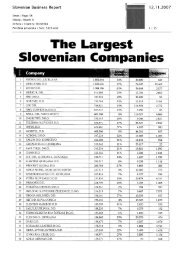The Group KD Group and KD Group dd
The Group KD Group and KD Group dd
The Group KD Group and KD Group dd
Create successful ePaper yourself
Turn your PDF publications into a flip-book with our unique Google optimized e-Paper software.
<strong>The</strong> <strong>Group</strong> <strong>KD</strong> <strong>Group</strong> Annual Report 2009<br />
Notes to Consolidated Financial Statements as at <strong>and</strong> for the year ended 31 December 2009<br />
<strong>The</strong> <strong>Group</strong> regularly checks the adequacy of liability calculations <strong>and</strong> the adequacy of assumptions used in the calculation of<br />
higher liabilities stemming from insurance contracts. <strong>The</strong> <strong>Group</strong> also carries out liability adequacy tests. If the liability<br />
adequacy test indicates that the liabilities are understated, they are increased.<br />
In the case of property insurance, an accurate estimate of the obligations of the reported <strong>and</strong> unreported claims is the most<br />
important factor, i.e. the assessment of liabilities assumed for any claims that are already registered, <strong>and</strong> obligations under<br />
insurance contracts for incurred but not reported claims (IBNR). Inaccurately estimated liabilities for reported claims also<br />
affect the calculation of IBNR. Contingencies may occur in the <strong>Group</strong> for which the obligations for claims were not designed<br />
(eg, in the past, asbestosis), or liability insurances, where there is a gap of a number of years between the conclusion of the<br />
insurance contract <strong>and</strong> the time when the claim is reported.<br />
For insurance contracts with DPF component <strong>and</strong> unit-linked insurance contracts, assumptions on future mortality, interest<br />
rates, contract terminations <strong>and</strong> administrative costs are applied. <strong>The</strong>se assumptions are used to determine liabilities<br />
stemming from the insurance contract. <strong>The</strong> assumptions also include a risk adjustment.<br />
For estimations on the mortality rate, mortality tables are used, as in the past the portfolio of insurance contracts has been too<br />
small for it to be able to rely on its own experience. Thus, for insurances for the event of death <strong>and</strong> insurances for the event of<br />
death <strong>and</strong> maturity, the <strong>Group</strong> uses Slovenian mortality tables made in 1990–1992, <strong>and</strong> for annuity insurance it uses Austrian<br />
annuity tables from the year 1996. In comparison with 2008, the <strong>Group</strong> has not changed its assumptions regarding population<br />
mortality. In the context of managing insurance risk, actuarial services are constantly checking the applied assumptions<br />
against the actual damage result, by individual insurance product.<br />
It is the management’s assessment that Slovenian mortality tables adequately reflect expectations with regard to the maturity<br />
<strong>and</strong> mortality rate of the Slovenian population.<br />
In its long-term insurance products, the <strong>Group</strong> uses interest rates spanning from 2.75% (new insurance products) to 4% (older<br />
products). <strong>The</strong> adequacy of returns on investments of insured liabilities in the future is checked on a regular basis.<br />
On each reporting date the assumptions are reset to reflect current assumptions <strong>and</strong> are used to check whether the liabilities<br />
have been adequately evaluated. If the liabilities are inadequate, the assumptions are changed to reflect the current state.<br />
Current assumptions do not contain a risk adjustment.<br />
<strong>The</strong> assumption on mortality is determined using the statistical mortality rate <strong>and</strong> analyses of actual mortality of the insurance<br />
portfolio in the past <strong>and</strong> current year. Also, in cases of disability, statistical tables <strong>and</strong> the insurer’s own experience are used.<br />
<strong>The</strong> <strong>Group</strong> also regularly analyses the duration of insurance contracts <strong>and</strong> monitors the movements of such durations over<br />
the period by main product <strong>and</strong>, as necessary, by sales channel if more significant deviations occur. <strong>The</strong>se analyses are used<br />
when estimating the duration of insurance contracts with a view to providing the best possible assessment of the insured’s<br />
behaviour.<br />
<strong>The</strong> return on investment affects the amount of future payouts from insurance contracts. When determining returns, the <strong>Group</strong><br />
considers government bonds as risk-free securities, <strong>and</strong> for other securities risk adjustments are applied. Considering this <strong>and</strong><br />
considering the structure of investments for covering liabilities, the expected returns of the investment portfolio are calculated.<br />
Future costs are determined on the basis of current costs. A<strong>dd</strong>itionally, the assumption of future inflation is also used, which is<br />
based on the EU’s long-term projections for the euro currency.<br />
- Pricing risk applies to the risk that the amount of the insurance premium is not adequate for covering the insurance<br />
liabilities stemming from claims <strong>and</strong> operating costs. <strong>The</strong> reasons can vary, e.g. unsuitable statistical data, inadequate<br />
assessment of claims events, low premium due to competition, unsuitable premium for new products, unsuitable mortality,<br />
annuity, morbidity tables, inadequate amount of expenses calculated into the price of the product. Furthermore, we can speak<br />
about the adequacy of the probability tables used, which further expose the <strong>Group</strong> to risks of natural death, longevity, critical<br />
illness <strong>and</strong> accident.<br />
Already in the new product planning stage, the <strong>Group</strong> diligently checks <strong>and</strong> acquires the necessary statistics to confirm the<br />
suitability of the assumptions used. In the case of high-risk products such as a<strong>dd</strong>itional coverage for critical illness, the<br />
<strong>Group</strong>’s general terms <strong>and</strong> conditions allow the possibility of subsequent changes in the amount of the insurance premium if<br />
new statistics or claims events indicate that the premium is too low. Similarly, the <strong>Group</strong> diligently monitors the amount of<br />
actual costs <strong>and</strong>, after analysing these costs, calculates the amount of costs to include in the price of individual products,<br />
112







